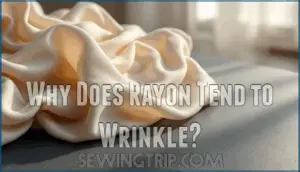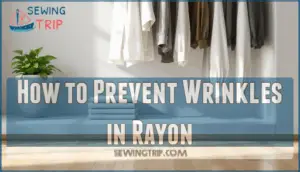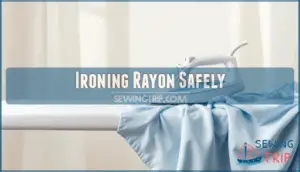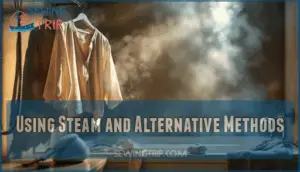This site is supported by our readers. We may earn a commission, at no cost to you, if you purchase through links.
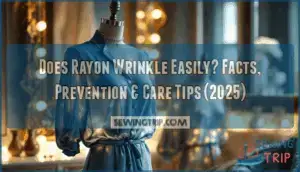
The molecular structure lacks the crystallinity that keeps synthetic fabrics smooth, so every fold, every sit, every arm movement leaves its mark.
Understanding why rayon creases so readily helps you choose the right garments, adjust your care routine, and master wrinkle removal techniques that actually work.
Table Of Contents
Key Takeaways
- Rayon wrinkles easily because its cellulose fibers have weak hydrogen bonds, low crystallinity (25-40% vs cotton’s 60%), and poor elastic recovery, meaning creases stay bent instead of bouncing back.
- Blending rayon with polyester or spandex dramatically improves wrinkle resistance—blends score above 4.4 out of 5 in wrinkle testing while pure rayon falls below 3.0, reducing crease formation by up to 45%.
- Proper care prevents most wrinkles: wash in cold water on gentle cycle, air dry by hanging or laying flat immediately after washing, and store on padded hangers or rolled loosely instead of folded.
- To remove existing wrinkles, iron rayon inside-out on low to medium heat while slightly damp, or use steam methods like handheld steamers or hanging garments in a steamy bathroom for gentler wrinkle relaxation.
Does Rayon Wrinkle Easily?
Yes, rayon wrinkles fairly easily compared to synthetic fabrics like polyester. The fabric’s structure and low elastic recovery make it prone to creasing, though proper care can help.
Let’s break down what affects rayon’s tendency to wrinkle and how it stacks up against other materials.
How Rayon’s Structure Affects Wrinkling
Rayon’s molecular makeup holds the key to understanding why this fabric seems to crease at the slightest touch. Unlike synthetic fibers with tightly organized molecular structures, rayon has:
- Lower crystallinity – fibers deform more easily when bent
- Poor elastic recovery – creases don’t bounce back naturally
- Weak hydrogen bonds – the fiber composition loses shape under pressure
- Minimal wrinkle resistance – fabric weave patterns can’t compensate for structural weaknesses
This molecular structure makes rayon behave more like natural fibers than its synthetic counterparts.
Rayon Vs. Other Common Fabrics
When you stack rayon up against other fabrics, the wrinkle situation becomes clear. Linen wrinkles more aggressively, while polyester stays smooth with almost no effort. Cotton without finishes scores around 3.2 in wrinkle resistance tests—rayon lands at 3.03. Treated cotton with sophisticated finishes reaches 4.78, leaving rayon behind. Polyester blends hit 4.44, proving synthetic fibers win the wrinkle-free battle hands down.
Understanding the properties of rayon vs cotton is essential for making informed fabric choices.
Factors Influencing Rayon’s Wrinkle Resistance
Your rayon’s fate isn’t sealed by the fiber alone—weave density, fabric weight, and chemical finishes all shift how quickly creases set in or smooth back out. Thicker weaves hold their shape better, while heavier fabric weight resists folding stress.
Moisture effects matter too—damp rayon loses structure fast. Lower crystallinity levels mean fibers bend easier, but wrinkle-free fabric treatments can compensate.
Understanding these rayon fabric properties helps you pick garments that actually survive your day without constant ironing.
Why Does Rayon Tend to Wrinkle?
Rayon wrinkles because of how its fibers are built and how you care for it. The fabric’s natural structure makes it bend under pressure and hold those creases longer than tougher materials.
Let’s break down the three main reasons your rayon pieces end up looking crumpled.
Low Elastic Recovery and Fiber Crystallinity
Think of rayon fibers as a loosely stacked deck of cards—they don’t spring back into place once bent. With crystallinity ranging from just 25% to 40% compared to cotton’s 60%, rayon’s molecular bonds lack the rigid structure needed for fabric stability.
This low elastic recovery means your rayon garments can’t bounce back from creasing, making wrinkle-free fabric a distant dream without proper fabric care and gentle ironing techniques.
Understanding the fabric characteristics is essential for maintaining the quality of rayon garments.
Impact of Weave and Fabric Weight
The density and pattern of your rayon’s weave create the first line of defense against creases—or, when poorly constructed, practically invite them in. Here’s how fabric density and weave patterns directly affect wrinkle prevention:
- Thread count matters: Higher thread count means tighter fabric density, which resists creasing better than loose, breathable weaves.
- Weight factors work double-duty: Heavier rayon fabrics naturally hang straighter, while lightweight versions wrinkle at the slightest touch.
- Complex weave patterns: Twill and satin weaves outperform plain weaves in wrinkle-free fabric performance.
- Texture analysis reveals truth: Smooth surfaces show every crease, while textured rayon cleverly disguises minor wrinkles.
Effects of Handling and Storage
Careless tossing, cramming, or folding rayon fabric accelerates wrinkle formation faster than almost any other management mistake you can make.
Proper storage tips include hanging garments on padded hangers or rolling them loosely instead of sharp fabric folding. These management methods deliver better wrinkle control than cramming clothes into tight spaces, and they’ll spare you from constant ironing rayon fabrics later.
How to Prevent Wrinkles in Rayon
You can’t stop rayon from wrinkling entirely, but you can make it much easier to manage.
The right washing, drying, and storage habits will keep your garments looking smooth longer.
Here’s what works best for rayon care.
Proper Washing Techniques
Washing rayon the wrong way is like crumpling a delicate piece of paper—once the damage is done, you can’t fully undo it. Always use cold water washing and the gentle cycle to protect the fibers.
Hand washing is even better for preserving rayon’s smooth texture.
Skip harsh fabric softeners—they weaken the material and increase wrinkling over time.
Best Drying Methods for Rayon
Your dryer can quickly turn rayon into a wrinkled mess—air drying is the safest bet. Lay garments flat or hang them immediately after washing to prevent wrinkle formation. If you must tumble dry, use low drying temperatures and remove items while slightly damp.
Follow these wrinkle prevention steps:
- Reshape wet rayon gently by hand before hanging to maintain the fabric’s original form and reduce creasing
- Avoid fabric softening sheets in the dryer—they coat rayon fibers and increase wrinkling over time
- Skip the dryer entirely for delicate rayon pieces like blouses or dresses to preserve their smooth texture
Storing Rayon Garments Correctly
Hanging rayon wrong or cramming it into a drawer can set wrinkles in stone—smart storage keeps your garments smooth and ready to wear. Use padded hangers for hanging methods to avoid shoulder creases, or try shelf folding along natural seams for folded storage tips.
Garment bags protect delicate pieces in your closet organization, while proper fabric care and clothing care tips guarantee wrinkle-free clothing stays spotless between wears.
Effective Ways to Remove Rayon Wrinkles
When wrinkles do appear in your rayon garments, you’ll want to know how to smooth them out without damaging the fabric. The right approach depends on the item and how much time you have.
Here are three reliable methods to get your rayon looking crisp again.
Ironing Rayon Safely
When you’re ready to press out those creases, treating rayon like a delicate fabric rather than sturdy denim can save you from scorched fibers and permanent damage.
Follow these ironing instructions to protect your garment while removing wrinkles effectively:
- Set your iron to low or medium heat—never high—to prevent fiber damage and shine
- Turn rayon inside out before ironing for extra fabric protection
- Use a pressing cloth between the iron and rayon to shield delicate fibers
- Glide the iron smoothly without applying excessive pressure or lingering in one spot
- Iron while the fabric is slightly damp for easier wrinkle removal and better results
Using Steam and Alternative Methods
If you don’t have an iron handy or prefer a gentler approach, steam can relax rayon fibers without the risk of direct heat damage. Hang your garment in a steamy bathroom, use a handheld steamer, or try a wrinkle-release spray for fabric relaxation and effective wrinkle removal.
These ironing alternatives deliver professional results without pressing directly on your fabric.
| Steaming Techniques | How It Works |
|---|---|
| Handheld Steam Iron | Direct steam penetrates fibers for quick wrinkle removal |
| Bathroom Steam Method | Moisture from hot shower naturally relaxes fabric |
| Wrinkle-Release Spray | Mist and smooth by hand—no heat required |
| Garment Steamer | Vertical steaming prevents crushing delicate rayon |
Product Examples: Yoga Pants, Blouses, Shirts
Real-world rayon products like yoga pants, blouses, and shirts each wrinkle differently depending on their blend, weight, and construction—so knowing what you own helps you care for it smarter. Lightweight rayon blouses crease faster than heavier rayon shirts with tighter weaves. Yoga pants with spandex blends resist wrinkles better than pure rayon garments.
Check your clothing care instructions and fabric selection tags—they’ll guide your garment care approach and help you match textile technology with proper apparel manufacturing standards for wrinkle-free fabric performance.
Are Rayon Blends More Wrinkle-Resistant?
If you want rayon that fights wrinkles better, blending it with synthetic fibers changes the game. Pure rayon wrinkles more easily than most blends, but the right combination can give you low-maintenance fabric that still feels great.
Here’s what you need to know about rayon blends and how to pick fabrics that stay smooth.
Benefits of Polyester and Spandex Blends
Blending polyester or spandex with rayon transforms a wrinkle-prone fabric into a low-maintenance wardrobe staple that holds its shape through wear and wash.
Here’s what these textile innovations bring to your clothing:
- Spandex stretch adds flexibility and helps garments bounce back, reducing creases from sitting or movement throughout your day.
- Polyester blends boost fabric durability and wrinkle-free performance, making them ideal for busy lifestyles requiring minimal ironing.
- Blend flexibility expands fabric selection options, combining rayon’s breathability with synthetic resilience for enhanced clothing materials.
Comparing Pure Rayon to Rayon Blends
Pure rayon wrinkles considerably more than rayon blends—laboratory wrinkle testing shows blends with polyester and spandex score above 4.4 out of 5, while pure rayon falls below 3.0.
Fabric blending with at least 30% synthetic fibers reduces crease formation by up to 45% and cuts ironing time by roughly 25%.
These fiber hybrids balance rayon’s breathable comfort with wrinkle-free performance, making rayon variants practical for everyday wear without constant pressing.
Choosing The Right Fabric for Wrinkle-Free Clothing
Your wardrobe decisions shouldn’t revolve around an iron—select fabrics based on their wrinkle resistance score, lifestyle demands, and the garment’s intended use to stay polished without the hassle.
When choosing wrinkle-free clothing materials, prioritize:
- Polyester-rayon blends for professional settings where garment care can’t interfere with your schedule
- Treated cotton when sustainable fabric options matter alongside performance
- Pure synthetics for activewear requiring zero maintenance after washing
Match fabric selection to textile science data, not marketing claims.
Frequently Asked Questions (FAQs)
What are the best ways to remove wrinkles from rayon?
You can remove wrinkles from rayon using gentle ironing techniques with low to medium heat settings. Steaming methods work well for fabric relaxation without direct contact.
For smooth finishing, hang garments in a steamy bathroom as an alternative wrinkle remover approach.
What are the reasons why rayon wrinkles easily?
Think of rayon fabric like a delicate memory foam—it holds impressions. Low elastic recovery and weak fiber crystallinity mean rayon deforms easily under pressure, creating stubborn creases.
Rayon wrinkles easily because its weak fiber structure holds creases like memory foam that never springs back
The material behavior stems from its textile science: those fiber properties lack the spring-back strength found in synthetics, making proper fabric care and ironing essential for wrinkle-free results.
What are some rayon blends that resist wrinkles?
Rayon, polyester, and spandex blends offer exceptional wrinkle resistance compared to pure rayon.
These wrinkle-free fabrics combine rayon’s softness with polyester’s recovery properties, achieving wrinkle resistance scores up to 44 through sophisticated fabric finishing techniques in textile science.
How can I prevent wrinkles from forming on rayon after washing?
Don’t panic if your rayon looks crumpled straight from the washer—that’s fixable. Remove garments promptly, gently shake them out, then hang or lay flat to air dry.
Skip the dryer’s tumbling heat. This gentle drying prevents wrinkles better than any ironing session.
How can I prevent wrinkles from forming on rayon while drying?
Air drying prevents wrinkles best—hang rayon garments immediately after washing while still damp, smoothing fabric gently with your hands. Skip the dryer completely, as heat sets creases.
For wrinkle-free results, use proper drying techniques and gentle treatment throughout the fabric care process.
Can rayon be dry cleaned without damage?
Yes, you can dry clean rayon, but check the care label first. Some rayon types tolerate dry cleaning well, while others may shrink or lose their shape. When in doubt, handwashing remains the safest cleaning alternative.
Does humidity make rayon wrinkle more quickly?
Humidity doesn’t directly cause wrinkles, but it slows drying after washing—keeping fibers damp longer, which locks in creases.
High moisture also reduces rayon’s breathability, making wrinkle formation more stubborn without proper climate control and fabric maintenance tips.
Is rayon suitable for travel clothing?
Over 60% of travelers cite wrinkles as a top packing frustration. Rayon isn’t ideal for travel clothing since it creases easily during transit.
Polyester blends offer better wrinkle resistance and fabric durability, making them smarter packing tips for wrinkle-free travel fabrics.
How does bamboo rayon compare to regular rayon?
Bamboo rayon shares similar properties with regular rayon—both are derived from cellulose and offer soft, breathable comfort. However, bamboo’s faster growth makes it more eco-friendly and aligns with sustainable fashion goals.
Both fabrics aren’t fully wrinkle-free, though sustainable bamboo production boosts its appeal without dramatically improving wrinkle resistance or fabric durability.
Will hanging rayon reduce wrinkles over time?
Picture a silk blouse left on a hanger overnight—by morning, gravity has done its work.
Hanging rayon can reduce minor wrinkles over time as the fabric’s weight naturally pulls creases out, making it an effective storage method for wrinkle relaxation and fold prevention in your fabric care routine.
Conclusion
Rayon’s molecular structure is like a memory foam mattress that never bounces back—every pressure point lingers. Once you understand does rayon wrinkle easily and why, you’re equipped to make smarter fabric choices, adjust your washing routine, and deploy the right tools when creases strike.
Hang garments properly, steam instead of crushing them in a dryer, and embrace blends when wrinkle resistance matters. Your rayon pieces don’t have to look like they survived a tornado—you’ve got the knowledge to keep them smooth.
- https://karminacollection.com/en/the-wrinkle-factor-which-fabric-materials-wrinkle-the-most-and-why/
- https://www.youtube.com/watch?v=k8_sIbF74P0
- https://zelouffabrics.com/blogs/news/why-rayon-fabric-is-a-fashionistas-favorite-key-advantages-and-care-tips
- https://www.whirlpool.com/blog/washers-and-dryers/how-to-wash-rayon.html
- https://nvlpubs.nist.gov/nistpubs/jres/20/jresv20n2p241_A1b.pdf

